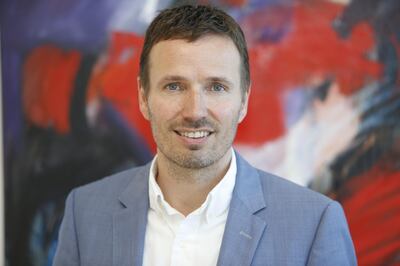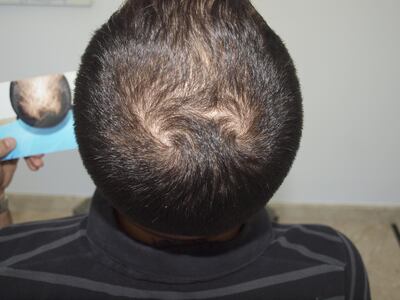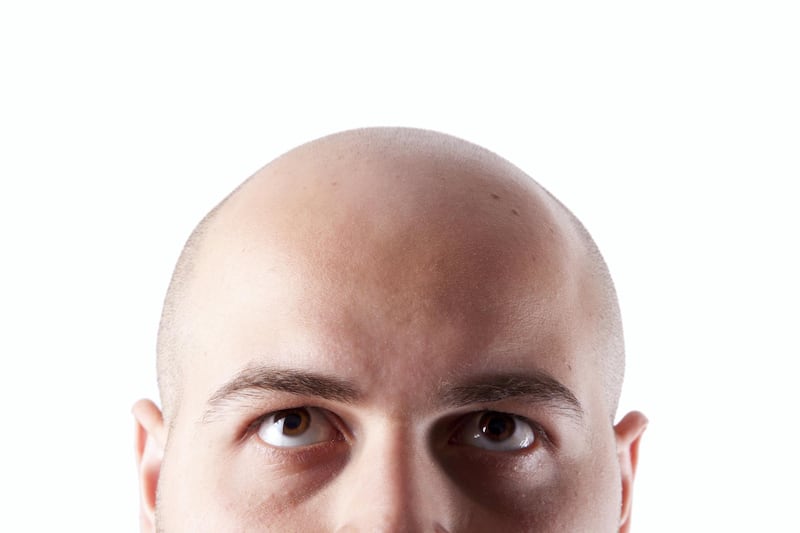“It’s a cliche,” admits Steve Buckley, a 39-year-old British expat working in the aviation industry, “but I decided to embrace my baldness. I began losing my hair in my early 20s and realised, looking at my family history, that it was going to be terminal. So I shaved it all off and have been hair-free, at least on my head, for the past 15 years or so. Everyone reacts differently to losing their hair, but baldness was an inevitability for me and I thought the best thing was to just get rid of what was still there – my wife has never known me to look any other way.”
It’s a familiar scenario, but many men who begin to lose their hair don’t deal with it in such a decisive and positive fashion. Going thin on top can have a devastating impact on the sufferer’s self-esteem, no matter how many times we’re told about baldness being a sign of virility. Some men reach for products on pharmacy shelves that make (usually empty) promises about regrowth results, while others attempt to cover over their pates with longer hair swept over the exposed area, or by never being seen without a hat. Some opt for transplants, some for hairpieces and wigs, and some, like Buckley, opt for full removal.
The decision to go bald... or not
Bruce Willis, Stanley Tucci, Moby, Jason Statham, Floyd Mayweather, Patrick Stewart, Vin Diesel, Mark Strong, Dwayne “The Rock” Johnson and, err, Heisenberg – all of them powerful, influential men, and all of them as bald as a coot. Yet, whenever I use the lifts where I live and see the ever-expanding patch of exposed scalp on my own head (thanks to their mirrored walls and ceilings), and I mentally consider the merits of taking it all off, I realise I’m just not prepared for that. I would look utterly ridiculous.
When I was much younger, my hair was very thick and very dark brown in colour – a combination that I knew wouldn’t last for too long because of my family history. My mother went grey very early on (as did her own mother, whom I never knew without a shocking white ’do), while my father was balding before I was born. “You’ll either go grey or bald,” I would say to myself while preening in the mirror before school. “Just pray it’s grey.”
And indeed, my hair began losing its colour before I turned 30, signalling what my wife likes to refer to as my silver-fox years. This positive spin on premature male ageing wears off after a while, though, and now, so too has my hair. I’m nearly entirely grey, I’m extremely thin on top and, yes, I’m upset about it. But what can one do to turn things around, apart from reaching for the razor or opting for a full-on midlife-crisis comb-over?
'Losing our hair can be viewed as an attack on us personally'
Lars Skjøth assures me that admitting defeat isn’t necessarily the only way, and if anyone should know, it’s him. He’s the founder of Hårklinikken, one of the world’s most trusted hair-regrowth specialists, and has been helping both men and women restore their locks since the first clinic opened in Denmark 26 years ago. The business now operates in 27 locations around the world and the Dubai clinic opened in 2012.
“We all have a picture of ourselves in our minds, of how we believe we look,” he says, “but then we see a photograph of us at a party, on holiday, or we catch our reflection in the lift or the unforgiving reflections of a clothes store changing room, that’s when we see the real thing. Losing our hair can be viewed as an attack on us personally, and it can make people extremely depressed to the point where some have even contemplated taking their own lives. It’s more than simple vanity.”

This is a point backed up by Peter Hilton, a UAE-based counsellor who helps many men overcome issues with body image and feelings of self-worth. He says that male pattern (hereditary) baldness is a constant reason for his clients seeking help, because they’re emotionally unable to cope.
“One man I used to treat, a British guy in his late 30s who had developed a very noticeable, circular bald patch,” he recalls, “actually got into a fist fight with someone who remarked about his hair loss. He snapped and the results weren’t pretty, but thankfully he sought advice and in time was able to deal with the change to his physical appearance. For him, it was basically a grieving process.”
Why the UAE is one of the worst offenders
Skjøth’s own crusade began when he was a youngster. He experienced ongoing problems with his scalp and made “countless visits to dermatologists, which didn’t help much”, resulting in his obsession with researching the science of hair loss. “That curiosity combined with studying nutritional science chemistry led me to where we are.” And where we literally are, is one of the world’s worst regions for hair loss in men and women, with more than a third of the population suffering visibly thinning manes.
“There are so many combined factors here in the Middle East that cause higher-than-average rates of hair loss,” Skjøth remarks. “Extreme heat, extreme light, humidity, air conditioning, stress – being constantly exposed to these things is bound to impact our lifestyles, how we function and how we respond to nutrition. And the lack of trace minerals in the water we use, not just in our own consumption, but also in agriculture and crop growing, affects everything from dairy products to the meat we eat. And that’s mutating our DNA to the point that it’s not selecting our hair as the most important thing anymore.”
He says that, contrary to popular myth, the quality of the UAE’s water supply has very little to do with hair loss. “I’ve visited parts of the world where the [tap] water is absolutely horrible, and the people there haven’t had the same problems with hair loss as we have here, where there is three to four times the rate of hair loss as Europe. In Dubai I’ve seen people from more than 100 different nationalities, with every imaginable scalp condition.”
The Hårklinikken process
Hair care for most men is an afterthought – if it’s a looking a bit greasy, give it a wash with some shampoo or other and that’s it, right? But even if we use the very best products, if we’re not getting the correct nutrients in our diets, then our hair will likely be adversely affected. And the research surrounding this issue is one that’s far from over for Skjøth, whose clinical studies focus on nutrient impact on skin and hair ageing, and the effects of fatty acids on insulin action, glucose tolerance, inflammation, blood cholesterol and triglycerides.
The Hårklinikken process begins with a consultation and physical examination, which involves disclosure about family history, lifestyle and nutrition, as well as an approximation of how much hair a client has so far lost. The examination involves a macro-magnification of the affected area of scalp and an analysis of condition to see how oily or otherwise it is. The resulting information is used in the laboratory to produce a customised formula for the products that are to be applied by the patient, and each one is as unique as the individual.
_______________
Read more:
Brushing off the stigma of baldness
Study: Bald men viewed as more confident, attractive
Comment: Growing bald gracefully appears to be on the decline with body image issues on the rise among men
_______________
For successful results, though, a patient must implicitly follow the directions given to them, which includes daily application of what the company calls Extract. This consists of derivatives from cow’s milk and natural occurring amino acid complexes, sterols, tannins and fatty acids from plants, which have been combined in a three-step fermentation process patented by Hårklinikken, and the formulation changes every time you get a new bottle to maximise its effectiveness. I’m told that many patients experience significant regrowth within four to six months.
Skjøth says that if we’re using the right products then daily washing shouldn’t be a problem. “There’s a lot of misinformation. To cleanse our scalp lets the skin breathe, as it removes the oils that build up, and trap in dirt and other contaminants. But the shampoos we tailor-make get rid of all the bad stuff while leaving what’s needed to restore growth.”

Sometimes people are beyond help and, for these, transplants (which basically involve scalp skin grafts) might be the only option, but that’s a complex, costly and invasive treatment, and isn’t guaranteed to last forever.
“We absolutely never take anyone on unless we know they can be helped,” Skjøth says. “What’s the point?” Quite. But what are we talking about when it comes to cost? When we consider some of the tens of thousands spent by the rich and famous to restore their hair, it’s natural to assume it’s prohibitively expensive for many. “For most people,” he confirms, “the products will cost about Dh600 a month. The initial consultation is Dh580 and follow-ups are about Dh350.”
That’s not cheap, but it’s a fraction of what I was expecting and I might sign up myself – my hair cut might not be trendy and it might be as grey as a UK winter sky, but I’m rather attached to it and I’d like to get some of it back.






